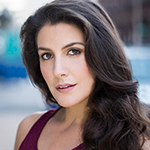Cecile McLorin Salvant
SFJAZZ, San Francisco, CA, September 19, 2015
Reviewed for Cabaret Scenes by Steve Murray
 All the buzz surrounding new jazz sensation Cecile McLorin Salvant is more than justified. At 26, she is redefining modern jazz with her extraordinary experimental arrangements and phrasing. Modulating frequently within a tune, she easily shifts between a childlike sing-song, a husky growl and a mature jazz vocal reminiscent of her predecessors Vaughan and Fitzgerald.
All the buzz surrounding new jazz sensation Cecile McLorin Salvant is more than justified. At 26, she is redefining modern jazz with her extraordinary experimental arrangements and phrasing. Modulating frequently within a tune, she easily shifts between a childlike sing-song, a husky growl and a mature jazz vocal reminiscent of her predecessors Vaughan and Fitzgerald.
The symbiosis with her bandmates Aaron Diehl on keys, Paul Sikivie on bass and Lawrence Leathers on percussion is exquisite. The four work as a seamless unit, creating expansive musical environments that fly, sometimes at breakneck speeds. The total result is mostly breathtaking.
McLorin Salvant digs back into the musical archives to update Bessie Smith’s 1926 hit “What’s the Matter Now?” (Clarence Williams/Spencer Williams) into sophisticated modern fun. She works similar magic on Sheldon Harnick’s “The Ballad of the Shape of Things,” a Blossom Dearie standby, and Bert Williams’s signature song “Nobody” (Bert Williams/Alex Rogers), a crowd-pleaser. Cecile certainly has wit, charm and an incredible skill set that belies her youth. She penned “Fog,” written after her last visit to San Francisco, and “Underling,” both from her latest studio release For One to Love, and they are as adventurous and modern as all of her material.
Set highlights included her off-the-chart arrangement of the American folk song “John Henry,” driven by the syncopated rhythms of Leathers and Sikivie that propel the song like a well-honed locomotive. An Aaron Diehl arrangement of “Somehow I Never Could Believe” from the Kurt Weill/Langston Hughes opera Street Scene is exciting in its eccentricity and emotional power.
The first time I saw McLorin Salvant, the crowd sat in hushed amazement. This time around, the usually staid jazz aficionados were hooting and shouting out requests.
She reacted with bemused acceptance of her newfound fame. Her audiences are more comfortable with the experimental nature of her music and jazz is all the better for it.





